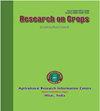利用 16S rDNA 对南非林波波省玉米(Zea mays L.)根部相关细菌 Serratia marcescens 进行分子研究
Q3 Agricultural and Biological Sciences
引用次数: 0
摘要
玉米是南非最重要的粮食作物,在多种环境下生产,容易感染危险的病原菌,需要更好的控制和管理。Serratia 是一种革兰氏阴性、兼性厌氧、运动性细菌,是影响玉米产量的细菌之一。在(需氧)营养琼脂平板上的菌落呈圆形,颜色为暗红色至粉红色。这项研究从南非林波波省的玉米田中分离并鉴定了沙雷氏菌。分子研究于 2022 年在林波波大学水产养殖研究室完成。为了鉴定与玉米有关的细菌,采用了 DNA Chelex 提取法,然后使用 16S rDNA 标记。经鉴定,该细菌为 S. marcescens。Nblast 分析显示,南非的 S. marcescens 与巴西(MH127785)和韩国(MN082049)的种群有 97% 的相似性。利用最大似然法进行的系统进化分析将该物种与分子鉴定为 S. marcescens 的物种归入同一支系,并获得高度支持(100)引导值。总之,使用 16S rDNA 可以正确识别该物种。不过,建议使用其他 DNA 标记来更好地了解 S. marcescens 的系统发育。本文章由计算机程序翻译,如有差异,请以英文原文为准。
Molecular study of Serratia marcescens, a bacterium associated with roots of maize (Zea mays L.), using 16S rDNA in Limpopo Province, South Africa
Maize the most important grain crop in South Africa produced under diverse environments is prone to dangerous pathogenic bacteria which needs better control and management. One of the bacteria that can affect maize yield is Serratia a gram-negative, facultatively anaerobic, motile bacterium. Colonies on (aerobic) nutrient agar plates are circular and have a dark red to pink colour. This study isolated and identified Serratia bacterium from maize fields in Limpopo, South Africa. The molecular study was done in 2022 at the Aquaculture Research Unit, University of Limpopo. To identify the bacterium associated with maize, for extraction DNA Chelex method was used then 16S rDNA marker was used. The bacterium was identified as S. marcescens. The Nblast analysis showed South African S. marcescens had 97% similarity with a population from Brazil (MH127785), and South Korea (MN082049). Phylogenetic analysis using maximum likelihood placed this species with those molecularly identified as S. marcescens in the same clade with highly supported (100) bootstrap values. In conclusion, this species is identified using 16S rDNA properly. However, using other DNA markers to understand S. marcescens phylogeny better is recommended.
求助全文
通过发布文献求助,成功后即可免费获取论文全文。
去求助
来源期刊

Research on Crops
Agricultural and Biological Sciences-Soil Science
CiteScore
1.50
自引率
0.00%
发文量
93
审稿时长
1 months
期刊介绍:
The Research on Crops is a peer-reviewed journal publishing original research papers, review articles and short communications in English on all basic and applied aspects of crop sciences, agricultural water management, agro-climatology, agroforestry, agronomy, crop production, crop protection, cropping systems, food science & technology, genetics & plant breeding, horticulture, plant & soil science, plant biotechnology, plant nutrition, post-harvest management of crops, seed science, soil management & tillage, vegetables, weed science, agricultural engineering, agri-business, agricultural economics and extension, etc. The aim of the journal is to provide a forum for the scientific community to publish their latest research findings.
The manuscripts submitted for publication should not contain data older than 4 years on the date of submission.
The articles submitted for publication in this journal should not be submitted elsewhere simultaneously for publication in another journal. These should not carry any copyright material without prior permission of copyright holder.
The articles should present a complete picture of the investigation made and should not be split into parts.
There is no prescribed limit regarding the number of pages in case of full-length articles. However, the authors are advised to keep the length of their articles from 4 to 10 full printed pages of the journal.
The articles should be divided into the sub-sections: ABSTRACT, INTRODUCTION, MATERIALS AND METHODS, RESULTS AND DISCUSSION, CONCLUSIONS, and REFERENCES. Tables and figures should be appended separately at the end.
 求助内容:
求助内容: 应助结果提醒方式:
应助结果提醒方式:


